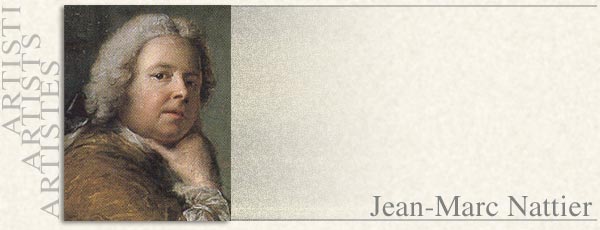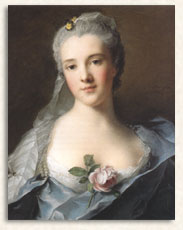|
|

|
1685 |
On March 17 Jean-Marc Nattier was born in Parid, in rue des Petits-Champs. His father was Marc Nattier, a portraitist of the Royal Academy of Painting and Sculpture, and his mother was Marie Courtois. Jean-Baptiste Jouvenet offered himself as godfather.
|
|
1700 |
On September 12 Jean-Marc Nattier became a student of the Royal Academy of Painting and Sculpture like his elder brother Jean-Baptiste.
|
|
1702/ 1704 |
Jean-Baptiste et Jean-Marc Nattier drew the tables in the Gallery of Luxembourg that had been painted by Pierre-Paul Rubens. |
|
1703 |
On October 13 Marie Courtois, Nattier’s mother, died. |
|
1705 |
On October 24 Marc Nattier, the artist’s father, died. |
|
1717 |
In Amsterdam Jean-Marc Nattie painted a table showing the Battle of Poltova for the Zar Peter I. |
|
1718 |
On October 29 Jean-Marc Nattier was aknolegded as a history painter by the Academy and presented "Persée qui change Phinée en pierre". |
| 1721 Date of birth of Madame de Pompadour |
|
1724 |
On June 26 Jean-Marc Nattier married Marie-Madeleine de La Roche in the church of Saint-Roch in Paris. |
|
1725 |
The artist showed the portrait of Maurice de Saxe on the occasion of the Youth Exhibition, held in Place Dauphine in Paris.
|
|
1729 |
Jean-Marc Nattier portrayed Mademoiselle de Clermont in the guise of the Goddess of healthy waters.
|
|
1731 |
He drew the facial features of the Regent’s daughters, Mesdemoiselles de Beaujolais and de Chartres. |
|
1732 |
The artist got some commissions by the duke of Richelieu. |
|
1734 |
At the Grand Prieur d'Orleans’s demand Nattier succeeded Jean Raoux in the decoration of the Palais du Temple in Paris and got a lodging by the enclore of the Temple. |
|
1737 |
His first exhibition at the Salon. The poet Jean-Baptiste Gresset defined Nattier as apprentice of the graces and painter of the beuty in the Mercure of France. |
|
1738 |
The public discovered the portraits of the marquise of Crèvecreur as Hebe and of the marquise of d'Antin.
|
|
1740 |
Nattier portrayed the two sisters of Madame di Mailly, Louis XV’s latest mistress. The marquise of La Tournelle appeared in the guise of the Day, while the marquise of Flavacourt represented the Silence.>The two pieces, now lost, were extremely successful.
|
|
1741 |
The artist painted the portrait of the countess Tessin, the Swedish ambassador’s wife in Paris. |
|
1742 |
Marie-Madeleine de La Roche, the painter’s wife, died. In the same yearthe master received his first commission by the Royal Family. He portrayed Madame Henriette, the Louis XV and Marie Leszczynska’s second daughter.
|
|
1744 |
The painter portrayed Louise-Henriette de Bourbon-Conti, the duchess of Chartres, in the guise of Hebe. |
| 1745 The arrival of Madame de Pompadour at the court |
|
1745 |
Nattier painted the portrait of Madame Adélaide as Diana for the king’s room in the Choisy castle. |
|
1746 |
On March 26 the artist became associate professor of the Royal Academy of Painting and Sculpture. Since August 25 the portraits of Joseph Bonnier de La Mosson and Madame de Baglion in the guise of Flore hasùd been showed at the Salon. First portrait of Madame de Pompadour in the guise of Diana.
|
|
1747 |
On Februay 6 Marie-Catherine-Pauline Nattier, the master’s eldest daughter, got married with the portraitist Louis Tocque.
September - at the abbey of Fontevrault he portrayed the king’s daughters: Madame Victoire, Sophie and Louise.
|
|
1748 |
April - Nattier worked on the portrait of Marie Leszczynska in city costume, which he would show at the Salon some months later. Second portrait of Madame de Pompadour in the guise of Diana (Saint Omer).
|
|
1750 |
Between August 25 and October 8 Nattier showed the portrait of Madame Marsollier and her daughter, which he had painted the year before. He met Giacomo Casanova. |
|
1751 |
Since August 25 he had showed the portraits of Mesdames at the Salon. Drawn in the guise of the four elements, these portraits were painted for the grand cabinet du Dauphin in Versailles.
|
|
1752 |
On May 27 Nattier was appointed as professor at the Royal Academy of Painting and Sculpture. |
|
1754 |
June - Jean-Frederic-Marc Nattier, the artist’s son, was drawned in the waters of the river Tiber. |
|
1758 |
The painter finished the portrait of Madame Adélaide in the court costume holding a music book.
|
|
1759 |
Presentation of his works at the Salon: the first negative critics by Diderot. |
|
1761 |
His bad health forced him to stay home. |
|
1762 |
July - a crisis of Hydropsy compelled him to bed definitely. |
|
1763 |
On June 27 all drawings, tables, printings, bronzes, porcelains and books belonging to Jean-Marc Nattier’s studio were sold. |
| 1764 The death of Madame de Pompadour |
|
1766 |
On November 7 Jean-Marc Nattier died in his daughter Madeleine-Sophie’s house in rue du Sentier. He was buried in Saint-Eustache’s in Paris.
|
 zoom |
TITLE: |